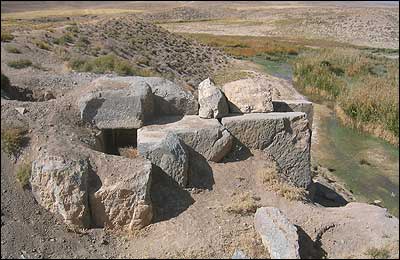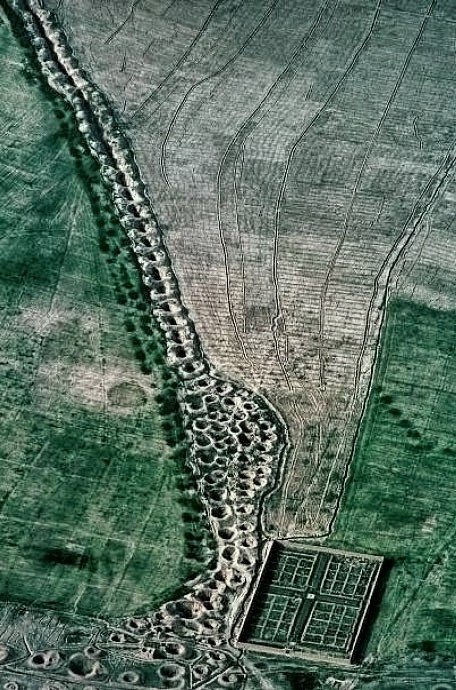The site of Pasargadae in Iran is host to the tomb of Cyrus the Great and is also the site of the ancient Persian Gardens known as Paridaeza (Paradise). The term “Paridaeza” (which roughly means “enclosed encampment” in ancient Median) has linguistic relations with the Indo-European term “Perimeter“.
There are reports of yet another interesting discovery near the site of Pasargadae dated to the Achaemenid dynasty (550-330 BC): the discovery of at least eight different dams at the Pasargadae locale (see report in CAIS).
 Partial view of the dam excavated by a Franco-Iranian archaeological expedition in February-March 2008. The site is approximately 30 kilometers distant from Pasargadae.
Partial view of the dam excavated by a Franco-Iranian archaeological expedition in February-March 2008. The site is approximately 30 kilometers distant from Pasargadae.
These have been discovered by an archaeological team of Iranian, Belgian and French researchers. The team excavated the Achaemenid dams in the Morghab plain, in southern Iran.
The region of Pasargadae and its environs is one of Iran’s most ancient plateaus with archaeologists having already discovered artifacts dating to several millennia B.C. As noted by a French expert of the archaeological team:
“Since recognizing the irrigation system of ancient people, especially those living under the reign of the Achaemenid Empire, is significant, we attempted at discovering archaeological structures with help of the past research projects and newly developed tools”
The team discovered 8 ancient mud-brick dams. Aerial photography and other techniques have dated these to the Achaemenid era. Two of those dams were over 20 meters tall with the height of the remainder ranging between 8 to 10 meters. Another expert of the archaeological team stated that these irrigation dams featured stone floodgates.
 Excellent aerial photogrpah taken in 1976 by Georg Gerster of an Qanat irrigation system. For more on Qanats consult article “Qanats of Iran“(Picture source: Iranfacts).
Excellent aerial photogrpah taken in 1976 by Georg Gerster of an Qanat irrigation system. For more on Qanats consult article “Qanats of Iran“(Picture source: Iranfacts).
Interestingly, the French archaeologists have also been involved in the excavations of an Achaemenid palace (attributed to Cyrus the Great) in the Tang e Bolaghi Valley.
Iranian archaeologist Hamidreza Karami, who is a specialist of Pasargadae, reported on these findings on April 1, 2008. Karami noted that the team had actually discovered two dams dated to the Achaemenid era: (approximately 2500 years) at Tang-e Hanā (Hana Pass). It is believed that the dams had been constructed during the earlier days of the Achaemenids.
According to Karami the dams were most likely constructed to power some type of industrial projects. One possibility according to Karimi was that the dams were powering mills. This is possible as there were no agricultural works in the area that depended on irrigation 2500 years ago.
Karimi also added that one of the purposes of the dams may have been to prevent floods from the Sivand River from swamping the area. As noted by Karimi, the water channels of the second dam are lower than the first dam. Also, the reservoir that would have been formed by the second dam would have been larger than the first dam.



